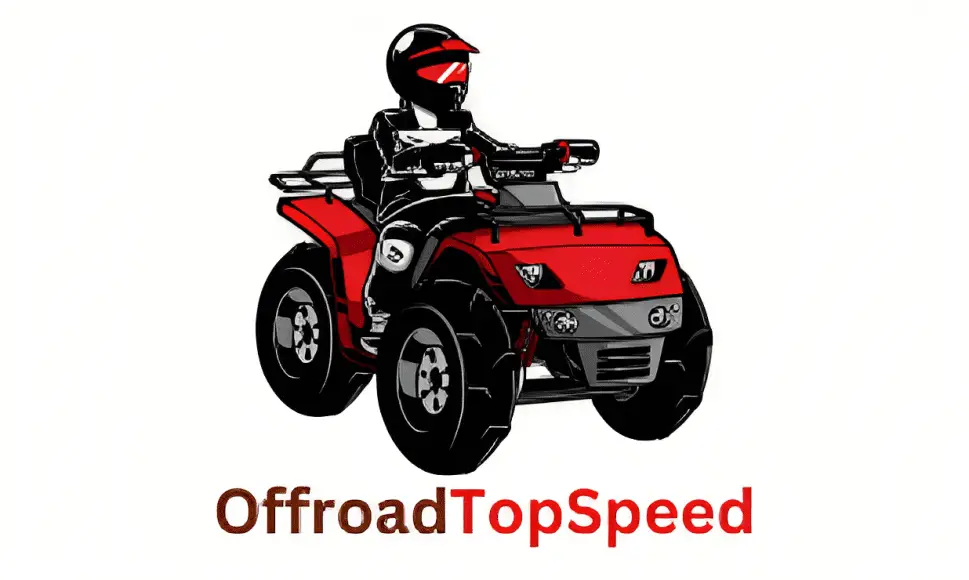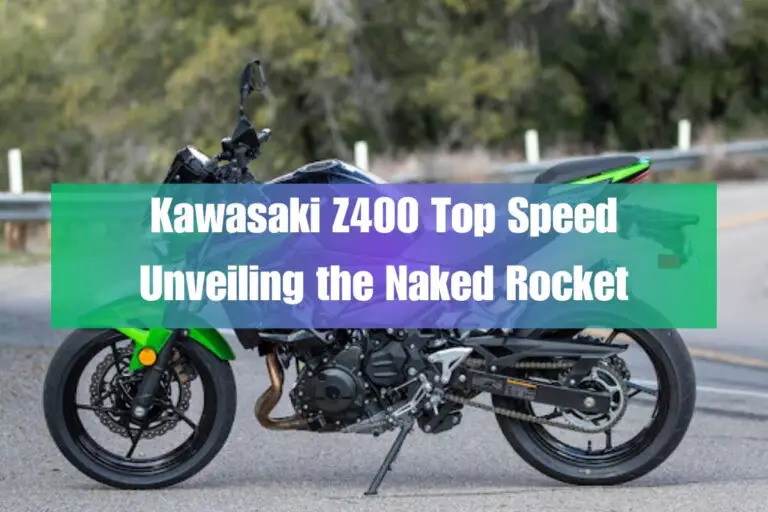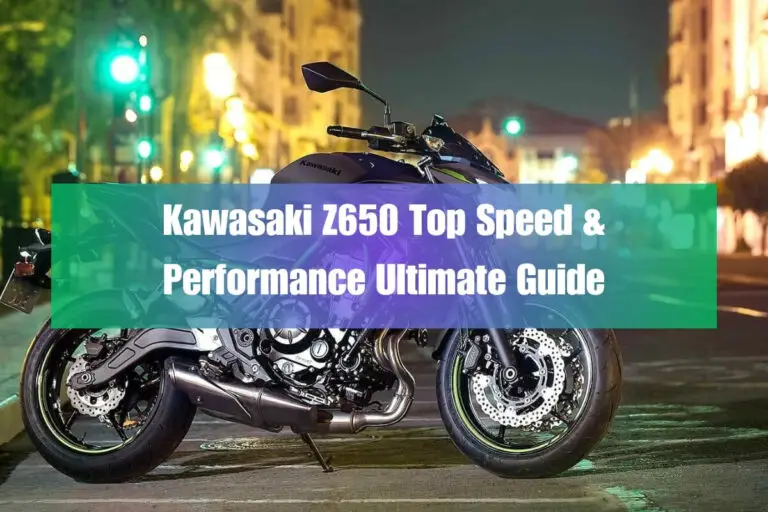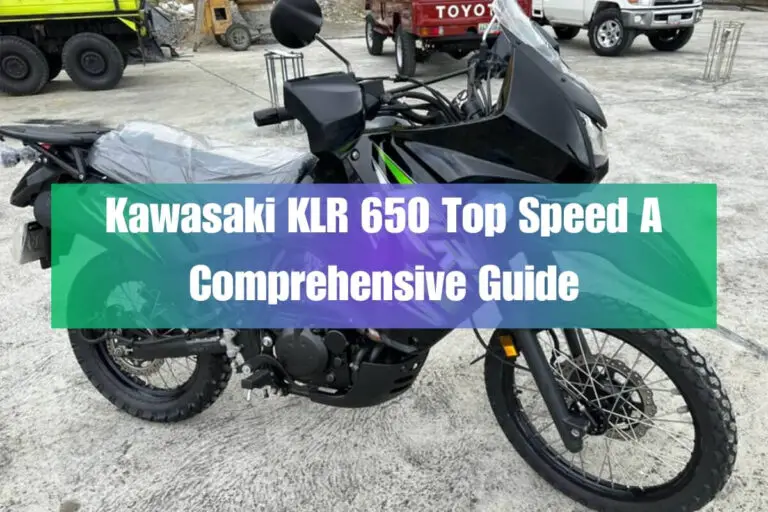Kawasaki KLX300 Top Speed: How Fast Can It Really Go?
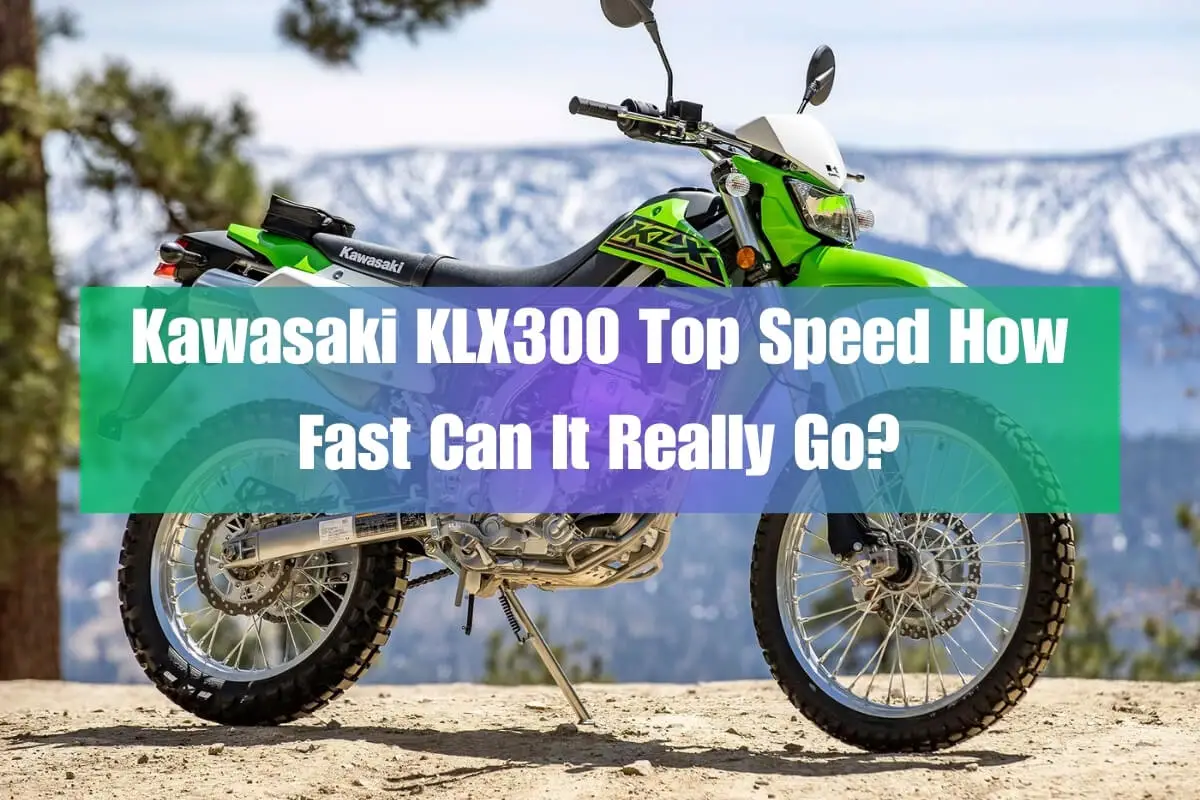
The Kawasaki KLX300 is a popular dual-sport motorcycle that allows riders to explore both on and off-road adventures. One of the most common questions about this versatile bike is: how fast can the KLX300 really go? In other words, what is its actual top speed capability?
The KLX300’s 292cc liquid-cooled single-cylinder engine produces a modest but usable 24 horsepower and 15.6 lb-ft of torque. While not a powerhouse, this output allows the lightweight KLX to reach respectable top speeds in the 80-85 mph range according to testing. However, most owners find the sweet spot around 70-75 mph where the KLX remains smooth and composed.
This guide examines the Kawasaki KLX300’s top speed capabilities. It covers real-world speed tests and how the KLX300’s speed compares to other motorcycles. The guide looks at modifications that can increase the KLX300’s top speed. It determines if maximum speed is an important factor when considering this dual-sport bike.
KLX300 Performance – Top Speed, Acceleration & Riding Experience
So how fast can you actually expect to go on a Kawasaki KLX300? Based on reviews and owner reports, the general top speed consensus is:
80-82 mph: This seems to be the realistic upper limit most can achieve briefly on a stock KLX300. However, it requires ideal conditions like a slight downhill grade, no wind, and a lot of room to build up speed gradually.
75 mph: A more sensible real-world top speed you can maintain for extended periods on flat, smooth roads with no headwind.
45-60 mph: The optimal cruising sweet spot where the KLX300 feels most at home on the street. Keeping revs lower in this range provides a smooth, vibration-free ride.
As for acceleration, the KLX300 is no dragster but its light weight allows respectable performance off the line. Expect 0-60 mph times in the 7-8 second range in ideal conditions.
When it comes to the actual riding experience, the KLX300’s modest power delivers a fun but manageable thrill factor. The torquey low-to-midrange provides great usability for technical off-road sections while still allowing you to cruise comfortably at road speeds around 50-60 mph.
The capable suspension with 10+ inches of travel front and rear soaks up bumps surprisingly well for a budget-minded dual-sport. And the extremely light overall weight under 320 lbs makes the KLX incredibly flickable and agile both on road and off.
KLX300 Engine, Chassis & Technical Specs
To better understand the performance capabilities, let’s look at the KLX300’s key engine stats and chassis specifications:
Engine
- 292cc liquid-cooled single-cylinder
- DOHC, 4 valves
- 24 hp @ 8,080 rpm
- 15.6 lb-ft torque @ 7,750 rpm
- 6-speed transmission
- Chain final drive
Chassis
- Steel semi-double cradle frame
- 43mm inverted fork, 10 inches travel
- Uni-Trak rear shock, 9.1 inches travel
- Single 250mm front disc, 240mm rear
- 3.0 gallon fuel tank
- 302 lb wet weight
- 35.2 inch seat height
As you can see, the KLX300 features a compact but modern thumper engine design utilizing dual overhead cams and four valves for good peak power. Hitting redline around 9,000 rpm allows accessing that ~80 mph top speed.
But with only about 26 horsepower on tap, there’s a limit to how quickly it can build speeds much beyond 80 mph. The short gearing optimized for off-road also runs out legs at higher road speeds.
Where the KLX300 truly shines is with its light, flickable chassis built for tough dual-sporting duty. Long-travel quality suspension from the Kawasaki off-road line delivers plush comfort whether blasting down gravel backroads or soaking up big hits on the trail.
What Kawasaki KLX300 Owners Say About Top Speed
Of course, nothing beats insights directly from real-world KLX300 owners and their experiences. Here are some quotes covering the spectrum of satisfaction with the bike’s top speed performance:
Positive Reviews
“Is it the fastest bike out there? No, but that’s not really the point. For a dual-sport at this price, the top speed is more than enough for highway cruising stints. I’ve had my KLX up to an indicated 80 mph and it felt completely stable.”
“I’m very pleased with how the KLX performs on backroads and dirt. On pavement, I just keep it around 60 mph which is a sweet spot where it remains smooth and vibration free.”
“Coming from bigger bikes, I was worried the power would feel anemic. But the KLX300 has a nice punch down low which is what I value most for off-road terrain. 75 mph is plenty for me.”
Negative Reviews
“My main issue is just how quickly this bike runs out of steam over 70 mph. You’re pretty much bouncing off the rev limiter if you try and sustain higher speeds.”
“I wish Kawasaki would have geared this bike a bit taller from the factory to make better use of the engine’s power for highways. As it is, you’re screaming along at 80 mph just to do 70.”
“The top speed leaves a lot to be desired if that’s your priority. But to be fair, that’s just not what this type of dual-sport is really designed for.”
In summary, many satisfied KLX300 owners feel the top speed performance matches their needs and expectations given the bike’s versatile dual-sport positioning and budget pricing. The complaints tend to focus on the KLX300 lacking the extra headroom for more spirited highway riding or sustained very high speeds.
How the KLX300’s Top Speed Stacks Up Against Competitors
To further put the Kawasaki’s performance into perspective, let’s compare its top speed and power figures against a few key rivals in the mid-sized dual-sport class:
Honda CRF300L: Very similar 286cc liquid-cooled single making 27 hp. Tested top speeds around 85-87 mph. Features more low-end torque than KLX.
Yamaha WR250R: 250cc liquid-cooled four-stroke with 30+ hp. Kawasaki KLX300 Top speed around 85 mph. Class-leading performance in this category.
KTM 350 EXC-F: 350cc four-stroke producing over 40 hp. Top speed in the 90+ mph range but more expensive and street-oriented than the KLX.
As you can see, the Kawasaki KLX300 slots just behind bikes like the latest CRF300L for outright top speed by a few mph. But it’s not horribly outclassed, providing satisfactory real-world performance for most dual-sporting needs.
The KLX300’s more budget-focused engineering simply can’t match the higher-revving short stroke designs of bikes like the WR250R when it comes to top-end rush. But many riders feel the trade-off is worthwhile given the KLX’s low price point.
Modifications to Increase the Kawasaki KLX300’s Top Speed
For those who want to eke out a few extra mph at the top end, there are some popular modifications that can provide a boost to the KLX300’s outright speed potential:
Exhaust: An aftermarket full exhaust system is a common first mod to improve breathing. Quality slip-ons from makers like FMF or Yoshimura can add 2-3 peak horsepower.
Air Filter: Upgrading to a less restrictive air filter like those from K&N or Uni allows the engine to breathe better.
Rejetting/Tuning: Adjusting fuel mixture and ignition timing via rejetting or installing a power commander can optimize the engine for the new exhaust system.
Gearing: Installing a slightly taller rear sprocket or front countershaft sprocket effectively raises the KLX’s gear ratios for better top speed.
Internal Mods: For maximum power gains, popular internal upgrades for the 292cc plant include big bore kits, high-compression pistons, hotter cams, and porting/polishing the head.
However, it’s important to keep in mind that heavily modifying the engine can impact long-term durability and reliability. Major internal work also adds significant costs.
A lighter rotating mass from a flywheel weight reduction or replacing steel valves with titanium can allow the engine to rev higher and make more power up top as well.
On the chassis side, reducing weight by swapping components like wheels/brake rotors for lighter alternatives helps acceleration and top speed. But maintaining adequate braking for a given speed is critical.
Overall, a combination of a less restrictive exhaust, proper rejetting/fueling, and gearing changes offers the most bang for your buck in reasonable power and top speed gains.
Pros and Cons of the Kawasaki KLX300’s Performance
To summarize the overall performance picture of the Kawasaki KLX300, let’s look at some key pros and cons relating to its speed and power:
Pros
- Light, nimble, and flickable chassis makes it extremely agile
- Torquey low-to-mid power delivery is ideal for technical off-roading
- Fast enough for highways in the 60-70 mph cruise range
- Excellent fuel efficiency thanks to modest engine size
- Beginner-friendly linear power delivery, not an intimidating powerhouse
Cons
- Limited top speed potential capped in the low 80s mph
- Short gearing causes buzzy high RPM at higher road speeds
- Not well-suited to wide open high-speed fire roads or desert rides
- Smaller cockpit/Wind protection makes higher speeds less comfortable
- Lack of electronics (no traction control, riding modes, etc.)
As you can see, the Kawasaki KLX300 delivers suitable real-world top speed performance for its intended mission as an affordable, approachable dual-sport machine. It won’t blow anyone’s doors off in an outright drag race. But it has enough pep to keep up with traffic and cruise surprisingly well on light adventure tours.
Where the KLX faces its limitations is when you start pushing harder into the upper RPM ranges that strain the small engine’s power band. So if raw speed and passing power take priority, you may want to look at larger dual-sport options.
The Best KLX300 Alternatives to Consider
Speaking of those higher performance alternatives, here are some of the top bikes to cross-shop against the Kawasaki KLX300 if ultimate speed is your main concern:
Yamaha WR250R: Revvier 250cc motor makes about 30 hp. Top speed around 85-90 mph. Significantly more expensive than KLX300.
Honda CRF450RL: Potent 450cc liquid-cooled single from Honda’s performance off-road line. 0-60 in under 4 seconds and tops out around 100 mph. Built more for pure off-road use.
KTM 500 EXC-F: Torquey 510cc thumper putting out over 50 hp. Top speed in the 100 mph zone. Extremely capable but also pricey dual-sport.
As you can see, to gain a significant top speed advantage over the KLX300 often means moving into the larger and more expensive 450-500cc dual-sport category. Or opting for a more specialized off-road competition bike that makes sacrifices for on-road manners.
For some riders, that trade-off makes sense to have the extra speed headroom when tackling wide-open terrain at higher pace. But for most dual-sporting adventures focused on backroads and tighter trails, the KLX300 hits a nice performance sweet spot in terms of value and versatility.
Who Should Buy the Kawasaki KLX300?
With all that in mind, the ideal customer for the Kawasaki KLX300 dual-sport checks these main boxes:
✓ You want a balanced, approachable middle-weight dual-sport
✓ Top speed isn’t your biggest priority but you need highway capability
✓ You value light weight and flickable handling for trails
✓ You’re on a budget; the KLX300 undercuts premium Euro rivals
✓ You’re looking for an affordable, efficient bike to start dual-sporting
On the flip side, the KLX300 may not be the best fit if:
- You demand blistering accelerations and top speed over 90 mph
- You plan to do a ton of high-speed fire road or desert riding
- You want cutting-edge rider aid electronics and tech features
- You’re a larger/taller rider who would feel cramped
- You need higher payload and range for serious adventure touring
With its modest but peppy engine, plush long-travel suspension, and low weight under 320 lbs, the Kawasaki KLX300 absolutely shines for tight, technical off-road riding. Its versatile dual-sport capability also makes it a great choice for commuters who want to mix in some light off-pavement exploring.
But for those looking to truly push the envelope on speed and straight-line performance, spending a bit more on a larger displacement bike like the WR250R, CRF450RL, or KTM 500 EXC may prove a better long-term investment.
Common KLX300 Issues & Maintenance Tips
Like any motorcycle, the Kawasaki KLX300 can experience its share of issues over time and miles. Being prepared with some common problems to look out for—and basic maintenance knowledge—is important for any owner.
A few issues that tend to pop up in KLX300 owner forums and communities include:
- Stalling:Ingham Fuel Injector failures resulting in stalling are reported, may require replacing injectors
- Hard Starting: Vacuum leaks can cause tough hot start issues, inspect lines and fittings
- Overheating: Radiator fan failures can lead to overheating, particularly in hot weather
- Battery Drain: Parasitic battery draws may require load testing the stator and regulating charging system
For basic maintenance to keep your KLX300 in top shape, key tasks include:
- Oil Changes: Kawasaki recommends full synthetic oil changes every 3,700 miles
- Valve Lash: Checking/adjusting valve lash around 15,000 miles
- Coolant Changes: Drain and refill with fresh coolant around 24,000 miles
- Air Filter: Clean or replace air filter regularly, especially after riding in dust/mud
- Chain Lube/Tension: Inspect/lube chain every few hundred miles and adjust slack as needed
Many KLX300 owners also recommend upgrading or adding a few key items:
- Skid plate to protect the engine case
- Handguards to deflect debris from levers
- Aftermarket seat for improved long-distance comfort
- Rear rack/case system for storage on longer rides
Overall, the Kawasaki KLX300 maintains a solid reputation for reliability when properly maintained. But being vigilant about fluid levels, battery condition, and wear items will help it remain a smooth runner for years of adventuring.
Frequently Asked Questions About the Kawasaki KLX300
What is the KLX300’s actual top speed?
In optimal conditions with a fresh motor, most testing shows a top speed around 80-82 mph. A realistic sustained top speed is closer to 70-75 mph.
Can you increase the KLX300’s top speed? How?
Yes, common mods like exhaust, air filters, rejetting, and gearing changes can net modest top speed gains of 5-10 mph. For major increases, you’ll need internal engine mods like big bore kits and hot cams.
How does the KLX300’s off-road performance compare?
Thanks to its low weight and long-travel suspension, the KLX300 is an excellent technical trail bike. The smooth, broad powerband gives great traction in tricky terrain.
Is the KLX300 good for taller riders?
At just over 35 inches, the seat height can be cramped for riders around 6 feet or taller. Shorter people may find the KLX300’s ergo’s roomier.
What’s the typical fuel range/efficiency?
With a 3-gallon tank and fuel-injected design, most owners report getting 50-60 mpg for a theoretical range around 150-180 miles.
How much does the KLX300 cost?
The 2024 Kawasaki KLX300 has an MSRP around $6,199 for starters models, with some color/graphics options costing slightly more.
What’s included from the factory?
The KLX300 comes pretty basic as a dirt bike platform with off-road tires and long travel suspension. No luggage racks or handguards are included.
How does the reliability compare to other Kawasaki dual sports?
Owner reports suggest the KLX300 is a strong, reliable machine if properly maintained per service intervals. It benefits from Kawasaki’s quality off-road engineering.
Final Thoughts and Key Takeaways
The Kawasaki KLX300 dual-sport offers a nice balance of performance for both on-road and off-road riding. While not a speed demon, its modest 292cc single provides enough pep to reach real-world top speeds in the 70-82 mph range.
For highway commuting stints or backroad exploring, the KLX300 has sufficient punch to keep up with traffic flows up to around 70 mph in its sweet spot. The short gearing optimized for off-road does mean higher RPMs and more buzz when pushing past 75+ mph for extended periods.
When it comes to tight, technical trails however, the KLX300’s lightweight and long-travel suspension shine. The smooth, torquey power delivery excels at providing traction over obstacles while remaining approachable and nimble. Dual-sporting is where this Kawasaki really shines.
There are certainly faster options from the start if blistering speed and acceleration take priority. But the KLX300 hits a sweet spot of capability and value that makes it a great all-rounder for newer adventure riders or those on a budget.
Simple bolt-on modifications to the intake, exhaust, and gearing can extend the top speed potential a bit as well. Just be wary of going too far down the modification rabbit hole and compromising the KLX’s renowned reliability and ease of maintenance.
